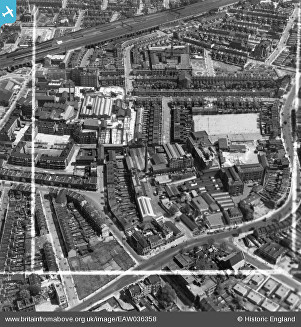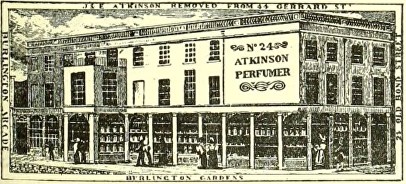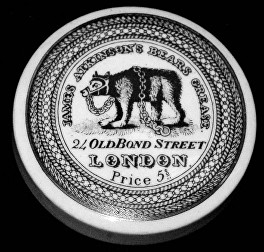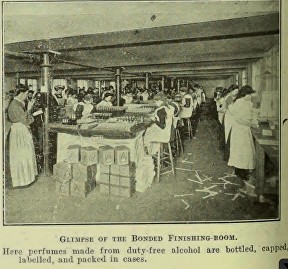





Exploring Southwark and discovering its history


Latest Pages:
Eonia Soap Works, Southwark Park Road
The Eonia Works were situated at the north western end of Southwark Park Road on land now incorporated into the playing fields of the Harris Academy. Opened in 1911, it was named after one of the ranges of products produced at the factory by J & E Atkinson, a longstanding perfume and cosmetics company founded by James Atkinson in 1799. Their first product was a rose scented hair pomade made from bear grease - sounds disgusting! According to the present Atkinson’s website, 18 year old James Atkinson set out from his native Cumberland for London with recipes for toiletries and perfumes and beside him in the carriage was a sizeable quantity of rose-scented bear grease together with a bear who was said to be devoted to James. James set up shop at 44 Gerrard Street and the pomade was an instant success with the upper classes despite, it was said, having to brave the bear chained up outside the shop to make their purchases.



Eonia Soap Works from Britain from Above website
From Grace's Guide
The bear grease was imported from St Petersburg and scented with Otto of Roses and advertised as “the only article that can be depended upon for infallibly restoring the growth of hair”. Other products in the range included Atkinson’s Vegetable Dye to dye red or grey hair, moustaches and beards brown or black, Atkinson’s Curling Fluid and Atkinson’s Old Brown Windsor Soap. There was also ranges of fragrances including Essence of Lavender, Persian Bouquet of Rose, Otto of Rose, and what has been described as a “fearlessly English” eau de Cologne. Atkinson’s scents found favour with Beau Brummell, Napoleon, The Duke of Wellington, Lord Nelson, Emma Hamilton and members of overseas royal families. In 1826 the company received the highest accolade when appointed the Official Perfumer to the Royal Court of England.
The business moved to premises in New Bond Street in 1829 and then again in 1832 to 24 Old Bond Street where the shop became a most fashionable destination for the aristocracy and high society. James’ brother Edward became a partner in the company in 1831 and the company became known as J&E Atkinson. James and Edward died in 1853 and 1856 respectively and the firm passed to James’ sons, James and Edward, who employed Eugene Barrett as general manager. Barrett became Managing Director upon the death of James Junior in 1895 and brought his son Horace into the company. Eugene Barrett was responsible for opening up overseas markets and exporting to countries across Europe, South America and Australia. New fragrances were added to the range including White Rose, Royal Briar, the British Bouquet and the Odd Fellow’s Bouquet, and individual perfumes were created for such exalted personages such as Queen Alexandra and Queen Mary.
To celebrate the company’s centenary a new special bouquet was produced that was later called Eonia. This was a very successful addition to the range and was said, by Atkinsons’, to typify “modernity in quality, style and artistic production; also determination to keep pace with present day evolution and progress in perfume taste, compounding and toilet production; while all that is best in the old is retained.”
The products were manufactured on various sites – goods for the home trade were produced in a factory in Covent Garden, for the export trade in a bonded factory where no tax was paid in St Katherine’s Dock. The bulk of production took place in Atkinson’s premises in Old Bond Street. In 1910, production was brought together under one roof in new premises on Southwark Park Road named Eonia Works. The premises at Old Bond Street remained as a showroom and for retail purposes but were destroyed by fire in 1923. Atkinsons rebuilt with a highly ornate building on the same site which still remains, home to Ferragamo’s London store. The building is Grade II listed and still bears the inscription ‘Atkinsons.’
Eonia Works had a classical Portland stone front and the pediment was inscribed with both the name of the firm and the works. The Chemist and Druggist of 29 April 1911 34 described the works as follows: “The site is shaped somewhat like a capital ‘L’ the shorter limb of which ends on the street front. There fine new offices have been erected, and behind them a series of one floored warehouses which internally are one mammoth hall, lighted by glass roofs, the whole being devoted to the storage of bottles, pots and kindred containers. The floor space is about 12,000 square feet. The offices and warehouse make up the shorter limb of the ‘L’. The interior of the office is most attractive, the private rooms not less so than the public office, for in these rooms have been gathered many fine pieces of old furniture which Mr Barrett and his predecessors used in the Old Bond Street house, and, however elegant modern oak furniture may be, there is homeliness and warmth about old mahogany that one likes.”

On site were two factories, one where duty had been paid for manufacture for the home market and the other a bonded factory where the alcohol used in the production of perfume was duty free that manufactured for the export market. The range of goods produced at Eonia Works was wide ranging and extended way beyond the various ranges of perfumes and included soap, cold cream, tooth-paste, shaving sticks and much more.
The years after World War I were difficult for Atkinsons and a block of 90,000 shares was acquired by Joseph Crossfield and Sons, a subsidiary of Lever Bros. These shares were sold to Lever Bros (Unilever) after World War II and in 1954 all production was transferred from Eonia Works in Southwark Park Road to a new perfumery block built on the site of Joseph Watson and Sons in Leeds, another Unilever owned company. Still the company failed to thrive and in the early 1960s the company was wound up and the Old Bond Street premises vacated. Atkinson’s perfumes are still available, one of these has been named 24 Old Bond Street.
Source:
Unilever Archives
Web discoveries
- UK Casino Not On Gamstop
- UK Casino Not On Gamstop
- Non Gamstop Casino
- Casinos Not On Gamstop
- Non Gamstop Casinos
- Non Gamstop Casinos
- Non Gamstop Casino
- Casino Sites Not On Gamstop
- Slots Not On Gamstop
- Casinos Not On Gamstop
- UK Betting Sites Not On Gamstop
- UK Casino Not On Gamstop
- Best Non Gamstop Casinos
- Betting Sites
- Non Gamstop Casino Sites UK
- Best Non Gamstop Casinos
- Non Gamstop Casino
- Casinos Not On Gamstop
- Non Gamstop Casino Sites UK